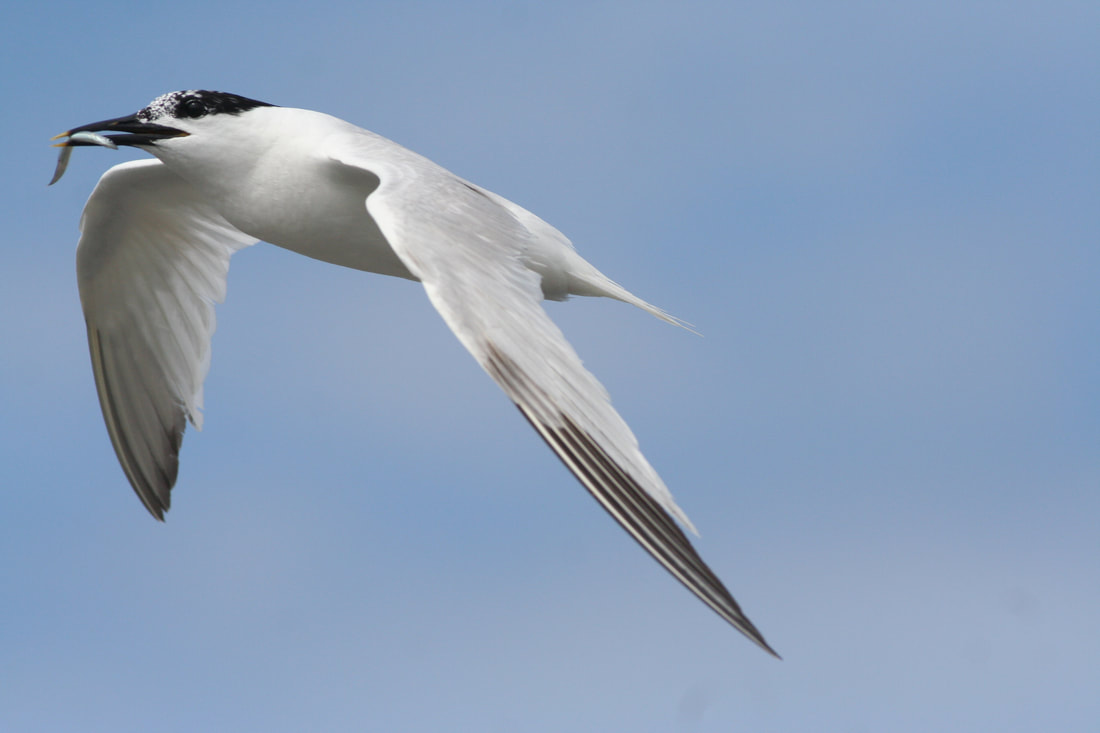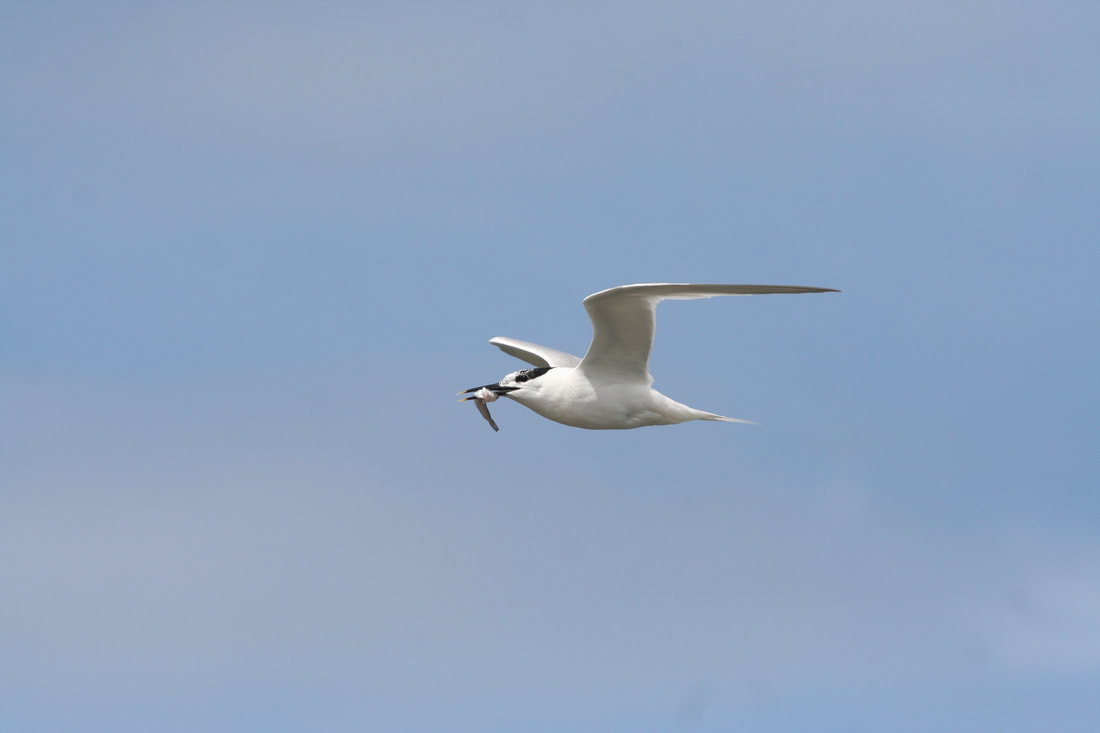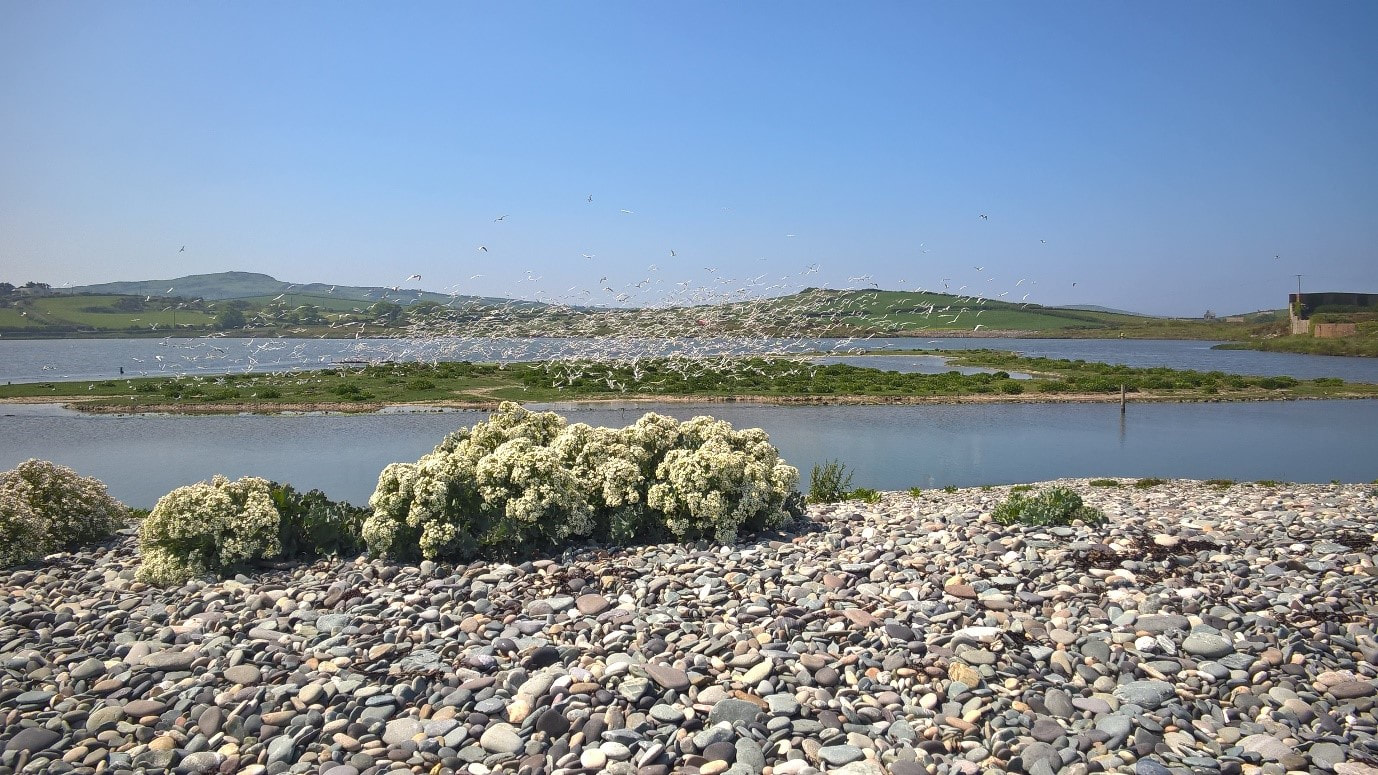|
North Wales Wildlife Trust’s Cemlyn wardens, Tarik Bodasing and Tim Morley tell the story of a remarkable summer. From a human point of view, the 2018 breeding season at Cemlyn appeared a little strange. In early May, hardly a tern was to be seen or heard and the colony comprised of mostly Black-headed gulls. It all looked rather bleak, and the Wardens started to wonder if they would have a job for the next few months! However; nature always has the ability to surprise us. Sandwich Tern started arriving from mid-May and settled down to the act of breeding. Common and Arctic Tern followed suit and by the end of May, 328 Sandwich (pairs), 3 Common (pairs) and 8 Arctic Tern (pairs) were confirmed to be nesting at the colony. Favourable weather conditions through June and July may have facilitated the good fishing, as foraging birds were observed to be bringing in sandeel after sandeel for the chicks. The end of June/early July brought another surprise, as the Sandwich Tern numbers almost doubled due to two further influxes. The Wardens were able to establish that these birds had likely come from RSPB Hodbarrow (Cumbria) where they had failed in their breeding attempt this season. This was particularly interesting, as Hodbarrow appears to serve as an alternate breeding site for these Sandwich Terns, and in recent years, has possibly even become the preferred site. For those who may not know, in 2017 the Sandwich Terns that abandoned Cemlyn actually re-laid at Hodbarrow and successfully fledged around 500 chicks! The two new influxes were soon confirmed to be an extra 190 pairs of Sandwich, and several more Common and Arctic Tern pairs, suggesting that some, but not all of the newcomers were actually giving it another go. This not only illustrates the resilience of the terns, but also the fact that single sites, while important, serve a greater function as part of a network, affording species like terns the ability to relocate, depending on local conditions and disturbances at specific sites. With disturbance in mind, a notable point this season has been the reduced level of disturbance by predators on the colony. While otters, fox, and stoat were known to be in residence, no attempts to get onto the islands were observed by the Wardens. Even aerial predation attempts were few, with peregrine and the larger gulls mostly disinterested in the colony. It is hard to say whether this is a result of the reduced sized of the colony this season (less of a magnet to predators), the electric fence, the abundance of alternative food sources, or a combination of all of these. The reduced level of predation allowed the Wardens to adopt a non-intrusive management approach, which appears to have paid dividends this season. We now find ourselves in early August, apparently at the very end of the season and yet, the terns are still here! The original nesters successfully fledged an estimated 120 chicks, and these birds have now all departed the colony. The remaining Sandwich Terns quickly moved over to the smaller island, bunching together for extra protection. A minimum of 72 chicks has been observed within this new group and we are keeping our fingers crossed that they will pull through before the adults feel the tug of migration. Common Tern have also done well in the 2nd influx, raising an additional 4-5 chicks (after a first wave of 8 chicks), to fledging age. Meanwhile the Arctic Tern only managed to raise ~4-6 chicks in total. A season at Cemlyn is of course, never complete without Roseate Terns and we were lucky to have several visits at the end of June/early July. Perhaps one day soon they will again choose Cemlyn as a nesting site, only time will tell. The Sandwich Terns of North Wales are a great example of how initial views can be misleading. As a species, 2017 turned out to be quite a successful year for the Sandwich Terns and certainly not a failed breeding season. Similarly, despite the slow start and concerns about further disturbance, the 2018 season must also count as a successful one, albeit in reduced numbers. From the terns’ perspective, their aim is to nest and raise young to fledging; where they do it is entirely of their choosing. Terns have the ability to deal with natural disturbances (as do most species of fauna and flora), but sometimes need a little helping hand along the way. The Wardens feel privileged to have spent the summer at such a special place, and with the tern orchestra for company, who can go wrong?!
3 Comments
Steve Ransome
20/8/2018 18:00:07
Brilliant work by so many folk. A real success story to be proud of.
Reply
david jones
21/7/2019 20:44:22
hi, i am disappointed to hear that bird ringing has taken place at cemlyn again this year.bird ringing and netting has become a national pastime alround the coast of anglesey, and the country and should be outlawed it does nothing but stress and in some cases harm these birds .there is no need for bird ringing anymore we allready know where these birds fly to and there habits.
Reply
Chris Wynne
22/7/2019 16:37:54
Hi David, thanks for your comments about the recent ringing work at Cemlyn. I think it warrants a detailed response which as Senior Reserve Manager for the North Wales Wildlife Trust, I am happy to do, so please bear with me.
Reply
Your comment will be posted after it is approved.
Leave a Reply. |
More Blogs to Read
AuthorThis blog is maintained by various people from the project team. Archives
August 2020
Categories
All
|
Roseate Tern LIFE Project is supported by the LIFE Programme of the European Union
LIFE14 NAT/UK/000394 ROSEATE TERN
LIFE14 NAT/UK/000394 ROSEATE TERN








 RSS Feed
RSS Feed